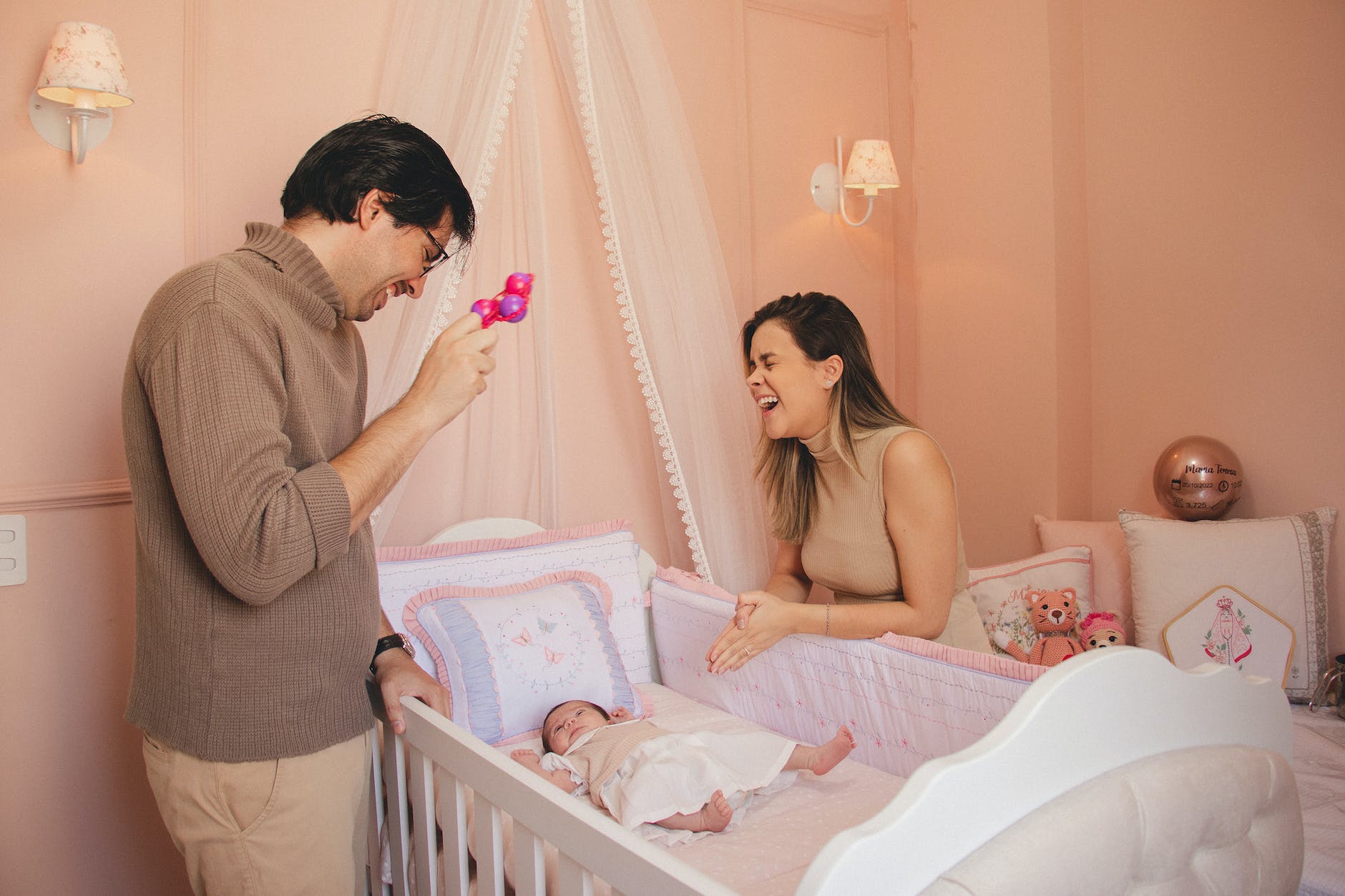How to Get a Baby to Sleep in Crib: Your Ultimate Guide

Parenting presents a myriad of challenges, and one of the earliest hurdles is teaching your newborn how to sleep in a crib.
Transitioning your baby from co-sleeping or a bassinet to their crib is a crucial milestone, but it often comes with sleepless nights and plenty of trial and error.
This guide will equip you with all the information and practical strategies you need to successfully navigate this significant transition.
Introducing a Crib to Your Baby

It’s never too early to familiarize your baby with their crib. This doesn’t necessarily mean they have to sleep in it from day one.
Start by allowing your baby to play or have tummy time in the crib during the day. This can help your baby form a positive association with the crib, making the transition smoother when the time comes.
What to do if your baby won’t sleep in the crib

Many parents face the challenge of a baby refusing to sleep in their crib. However, remember, every baby is unique, and what works for one might not work for another. Remain patient and try different techniques to discover what suits your little one best.
Tips and tricks for getting your baby to sleep in a crib

Establish a Bedtime Routine
Consistency is key to helping your baby understand when it’s time to sleep. A calming routine, such as a warm bath followed by a book or a lullaby, signals to your baby that it’s time to wind down.
Encouraging self-soothing
Finally, teaching your baby to self-soothe is an invaluable skill that will aid their transition to a crib. You can promote self-soothing by creating a consistent bedtime routine, using a security object, and giving them the chance to settle themselves without immediate intervention.
Remember, while this guide provides you with a general direction, every child is unique. Be patient, and flexible, and adjust your approach as needed, and eventually, you’ll find a routine that works best for both you and your baby.
Put Babies in Their Cribs Drowsy but Awake
This tip is golden. By placing your baby in the crib while drowsy but still awake, you’re teaching them to self-soothe and fall asleep independently, a crucial skill for their sleep development.
Understanding Baby’s Sleep Cycles
Understanding your baby’s sleep cycles can also be beneficial. Babies, especially newborns, have shorter sleep cycles than adults. They spend more time in rapid eye movement (REM) sleep, which is a lighter stage of sleep when dreams occur.
Due to these shorter cycles and more frequent REM sleep, babies wake up more often. Over time, as their nervous system matures, these sleep cycles will gradually start to lengthen.
Keep daytime active and nighttime quiet
Differentiating between day and night helps regulate your baby’s internal clock. Keep the days bright and full of activity, while nights should be quiet and dark.
Consider sleep training
If your baby continues to resist sleeping in the crib, it might be time to consider sleep training. There are various methods, from the gentle “no tears” approach to the more assertive “cry it out” method.
Present opportunities
Provide ample opportunities for your baby to sleep in the crib. For instance, start with daytime naps in the crib before transitioning to nighttime sleep.
When should a baby start sleeping in a crib?
While some parents choose to start from birth, the American Academy of Pediatrics recommends transitioning your baby to a crib by the time they’re six months old. However, each family and situation is unique. It’s crucial to make the transition when it feels right for you and your baby.
The benefits of sleeping in a crib
Having a baby sleep in their crib presents several benefits. It encourages self-soothing, promotes safer sleep, allows babies to become familiar with their environment, and fosters independence.
Common sleep regressions and how to deal with them
Consider consulting a pediatric sleep specialist
If you’ve tried all the techniques and your baby is still resisting sleep in the crib, consider consulting a pediatric sleep specialist. These professionals are trained to deal with various sleep issues and can provide valuable insight and practical solutions tailored to your baby’s needs.
Transitioning a baby to sleeping in a crib is a significant step for both parents and the baby. It may not always be a smooth journey, but with patience, consistency, and a lot of love, it is absolutely achievable. Take heart in knowing that every small victory is a step towards more restful nights for you and your baby.
Recognizing sleep cues
Babies often signal when they are tired and ready for sleep. These signals or ‘sleep cues’ can vary, but commonly include rubbing their eyes, yawning, looking away, fussing, and becoming quiet or still.
Recognizing and responding to these cues can make it easier to get your baby to sleep in their crib. Over time, as you learn your baby’s unique signals, it will become increasingly easier to establish a successful sleep routine.
Maintaining a comfortable room temperature
The temperature of your baby’s room can significantly impact their quality of sleep. Experts recommend keeping the room temperature between 68 to 72°F (20 to 22.2°C).
Also, consider the type and amount of clothing your baby is wearing to prevent overheating or chilling. A good rule of thumb is to dress your baby in one additional layer than what you are comfortable wearing.
The role of white noise in promoting sleep
White noise machines or apps can be an excellent tool for encouraging your baby to sleep in their crib.
The consistent sound can soothe your baby and drown out other noises that might wake them. However, make sure to place the machine or device at a safe distance from the crib and keep the volume at a safe level.
Teaching your baby the difference between day and night
Babies aren’t born with a circadian rhythm – the internal process that regulates the sleep-wake cycle. This is something they develop over the first few months.
You can help them understand the difference between night and day by exposing them to natural light during the day and keeping lights dim and the environment quiet at night.
Having patience and celebrating small victories
Remember, transitioning your baby to a crib is a process. It will take time, and there will be setbacks. It’s essential to stay patient and not to rush the process. Celebrate small victories along the way – every successful nap or night in the crib is a big step forward.
Helping your baby transition to sleep in a crib can be a challenging but rewarding process. It requires a blend of patience, persistence, and adaptation to your baby’s unique needs and signals. There is no one-size-fits-all solution, but with this comprehensive guide, you’re well-equipped to navigate this journey successfully. Happy parenting!
Using a pacifier to promote sleep
For some babies, using a pacifier can provide comfort and help them fall asleep in their crib.
If you choose to use a pacifier, make sure it’s always clean and safe for your baby’s use. Remember to wean your child off the pacifier gradually as they get older to avoid dependency.
Ensuring crib safety
While introducing your baby to a crib, it’s crucial to ensure the crib meets all safety standards. This includes a firm, tight-fitting mattress, a fitted sheet, and no loose bedding or toys that could potentially pose a suffocation hazard.
The crib should also be placed away from windows, heaters, lamps, wall decorations, and cords.
The power of a consistent bedtime
Having a consistent bedtime can work wonders in helping your baby adjust to sleeping in a crib.
This doesn’t just mean putting your baby to sleep at the same time each night, but also waking them up at the same time each morning. This consistency aids in setting your baby’s internal clock and promotes better sleep habits.
Dealing with separation anxiety
At around six months of age, some babies develop separation anxiety, which can make putting them to sleep in their crib challenging.
If your baby cries when you leave the room, reassure them with your voice or a soothing touch before leaving. Gradually, your baby will learn that they are safe, even if you are not in sight.
Understanding and responding to night wakings
Even after successfully transitioning to a crib, it’s normal for babies to wake up during the night. When this happens, wait a few minutes before responding to give them a chance to self-soothe and fall back asleep. If they continue crying, comfort them with gentle patting or soothing words.
In summary, teaching a baby to sleep in a crib requires a balance of comfort, consistency, and patience. Every baby is unique, so what works for one may not work for another.
Don’t be discouraged by setbacks and remember to celebrate progress, however small. Over time, your efforts will pave the way for healthy sleep habits, benefiting both you and your baby.
Sleep regressions are common and typically occur when a baby is going through a significant developmental milestone. They can happen at any age but are most common at around 4 months, 8 months, and 12 months.
During these periods, your baby’s sleep may become more erratic, and they may wake up more often. However, these phases are temporary and usually resolve within a few weeks. During a regression, try to stick to your routines as much as possible and offer comfort as needed.
How to get a baby to Sleep in Crib: Conclusion
Helping your baby transition to sleep in a crib can be a challenging but rewarding process. It requires a blend of patience, persistence, and adaptation to your baby’s unique needs and signals.
There is no one-size-fits-all solution, but with this comprehensive guide, you’re well-equipped to navigate this journey successfully. Happy parenting!
Also Read:
- When Should Baby Sleep In Crib In their Own Room
- Sleep Like A Baby: Tips and Tricks For Getting Your Little One To Sleep In Their Crib!
- How Long Can You Use a Mini Crib?
- From Newborn to Toddler: How Much Weight Can Your Crib Handle?
- Little Cribs, Big Comfort: Finding the Best Mini Cribs for Your Bundle of Joy
How to get a baby to sleep in crib FAQ
How do I get my baby to sleep in a crib for naps?
Start by making the crib a pleasant place for your baby. Ensure the crib is comfortable, safe, and calming. When your baby is drowsy, gently place them in the crib and stay nearby until they fall asleep.
How long will it take for my baby to get used to sleeping in a crib?
The timeline varies for each baby. While some babies transition smoothly, others may take weeks or even months. It’s essential to be patient and consistent in your approach.
How can I get my baby to sleep in a crib?
Introduce a transitional object, like a baby-safe stuffed toy or blanket. Also, try using a wearable blanket or sleep sack, which provides similar comfort but is safer for a crib.
How do I get my baby to sleep in a crib without crying?
Gradual adjustments can help. Start by laying them in the crib for short periods during the day while they’re awake. Over time, increase the duration until your baby is comfortable with the crib environment.
Can I train my baby to sleep in the crib?
Absolutely. While it may take some time and patience, your baby can be trained to sleep in the crib. Key to this training is consistency in routines, environment, and response to your baby’s cues.
